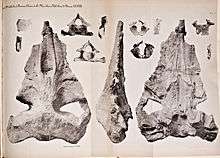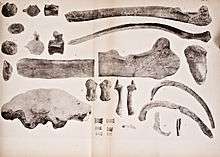Eschrichtioides
| Eschrichtioides Temporal range: Pliocene | |
|---|---|
 | |
| Eschrichtioides gastaldii, from Portis 1885 | |
| Scientific classification | |
| Kingdom: | Animalia |
| Phylum: | Chordata |
| Class: | Mammalia |
| Order: | Artiodactyla |
| Infraorder: | Cetacea |
| Family: | Eschrichtiidae |
| Genus: | †Eschrichtioides Bisconti 2008 |
| Species | |
|
†E. gastaldii | |
| Synonyms | |
| |
Eschrichtioides is an extinct genus of eschrichtiid known from the early Pliocene of northern Italy. Its type species, E. gastaldii, had a superfluous taxonomic history, starting as a cetothere, then as an extinct balaenopterid, before being finally recognized as a relative of the gray whale.
Distribution
Eschrichtioides is one of two eschrichtiids known from the Neogene of Italy, the other being Archaeschrichtius. Its holotype, MRSN 13802, comes from the early Pliocene-age Sabbie d'Asti Formation of the Piedmont region in Italy.[1]
Classification

Like other cetaceans from the Italian Pliocene, the classification of Eschrichtioides was highly contentious.
Brandt 1873[2] described several species of Cetotherium from the Pliocene of northern Italy, including C. cortesi based on a specimen (MSRN 13802) found by Italian geologist Giuseppe Cortesi in 1816 near the town Cortandone (45°00′N 8°06′E / 45.0°N 8.1°E: paleocoordinates 44°54′N 8°00′E / 44.9°N 8.0°E)[3]
Cortesi 1819 [4] described how he, after a day of searching for fossils, found what he first thought was a small piece of wood in a small river. After a closer inspection it proved to be a bone, and Cortesi and his companion found more and more of them in the banks of the river. After four days of digging they had unveiled a giant skeleton easily identifiable as a whale 12 feet 5 inches long. The three feet long head and its dentaries had no signs of either teeth nor tooth sockets. Cortesi noted that at that time few naturalists could assign cetacean fossils to individual species, and he therefore never named his specimen.
Desmoulins 1822[5] thought the "Baleine de Cortesi" represented a distinctive species because it was a very small adult individual and because the curvature of the maxillary branches was less convex than in any other known whale. Other French naturalists[6] named it "Le rorqual de Cortési"; arguing that both Cortesi's fossil whales ("rorqual de Cortési" and "de Cuvier") were closely related to extant rorquals and the only difference between them was the much smaller size of the former.
Brandt 1873[7] assigned the "baleine de Cortesi" to his own genus Cetotherium Cortesii.
In a preliminary note Strobel 1875[8] pointed out differences in cranial morphology in two skulls both described as "Cetotherium cortesii" (a species named and described by Brandt 1873), and he therefore proposed the new specific name "Cetotherium gastaldii" (in honour of Italian palaeontologist Bartolomeo Gastaldi) for one of the specimens. Strobel 1881[9] described the specimen and reiterated his arguments from 1875.
Originally misidentified as the balaenopterid "Balaena" cortesii, Brandt 1873 described "B." cortesii as a species of Cetotherium.[10] Strobel 1875 finally named it C. gastaldii.[11] However, several authors considered it to be referrable to Balaenoptera,[12] a taxonomic arrangement which was accepted for more than a century.[13][14] However, re-examination of MRSN 13802 revealed that "C." gastaldii was not a balaenopterid and instead constituted its own genus within Eschrichtiidae.[1]
References
Notes
- 1 2 Bisconti 2008
- ↑ Brandt 1873, pp. 153-156
- ↑ "Cortandone (Pliocene of Italy)". Fossilworks. Retrieved October 2014. Check date values in:
|access-date=(help) - ↑ Cortesi 1819, pp. 61-67
- ↑ Desmoulins 1822, p. 165
- ↑ Boitard 1861, p. 443; Gervais 1867, p. 461
- ↑ Brandt 1873, pp. 153-156̣
- ↑ Strobel 1875, p.136
- ↑ Strobel 1881, pp. 29-31
- ↑ Brandt 1873, pp. 153-156̣
- ↑ Strobel 1875, p. 136
- ↑ Portis 1885, p. 17
- ↑ For example Trouessart 1904, p. 782
- ↑ Deméré 1986
Sources
- Bisconti, M.; Lambert, O.; Bosselaers, M. (2013). "Taxonomic revision of Isocetus depauwi (Mammalia, Cetacea, Mysticeti) and phylogenetic relationships of archaic 'cetothere' mysticetes" (PDF). Palaeontology. 56 (1): 95–127. doi:10.1111/j.1475-4983.2012.01168.x. Retrieved November 2014. Lay summary (November 2014). Check date values in:
|access-date=(help) - Bisconti, M. (2008). "Morphology and phylogenetic relationships of a new eschrichtiid genus (Cetacea: Mysticeti) from the Early Pliocene of northern Italy". Zoological Journal of the Linnean Society. 153: 161–186. doi:10.1111/j.1096-3642.2008.00374.x. OCLC 438026086. Lay summary (November 2013).
- Boitard, P. (1861). "Baleines fossiles. mam.". Dictionnaire universel d'histoire naturelle (in French). Paris: L. Housiaux et Cie. Retrieved October 2014. Check date values in:
|access-date=(help) - Brandt, J. F. (1873). "Untersuchungen über die fossilen und subfossilen Cetaceen Europa's". Mémoires de L'Académie Impériale des Sciences de Saint-Petersbourg. 7 (in German). 20 (1): 1–372. Retrieved December 2013. Lay summary (December 2013). Check date values in:
|access-date=(help) - Cortesi, G. (1819). "Saggi geologici degli stati di Parma e Piacenza" (in Italian). Piacenza: Torchj del Majno. OCLC 421861898. Retrieved October 2014. Check date values in:
|access-date=(help) - Deméré, T. (1986). "The fossil whale, Balaenoptera davidsonii (Cope 1872), with a review of other Neogene species of Balaenoptera (Cetacea: Mysticeti)". Marine Mammal Science. 2 (4): 277–298. doi:10.1111/j.1748-7692.1986.tb00136.x.
- Desmoulins, A. (1822). Dictionnaire classique d'histoire naturelle (in French). Paris: Rey et Gavier. Retrieved October 2014. Lay summary (October 2014). Check date values in:
|access-date=(help) - Gervais, P. (1867). "Baleines fossiles. mamm.". Dictionnaire universel d'histoire naturelle par Ch. d'Orbigny (in French). 2 (2nd ed.). Paris: A. Pilon et Cie éditeurs. Retrieved October 2014. Check date values in:
|access-date=(help) - Portis, A. (1885). Catalogo descrittivo dei Talassoterii rinvenuti nei terreni terziarii del Piemonte e della Liguria (in Italian). Turin: Ermanno Loescher. OCLC 9527515. Retrieved November 2013. Lay summary (November 2013). Check date values in:
|access-date=(help) - Strobel, P. (1875). "Notizie preliminari su le Balenoptere fossili subappennine del Museo parmense". Bollettino del R. Comitato Geologico d'Italia (in Italian). 5 (6): 131–140. Retrieved November 2013. Lay summary (November 2013). Check date values in:
|access-date=(help) - Strobel, P. (1881). Iconografia comparata delle ossa fossili del gabinetto di storia naturale dell' Università di Parma. I. Balenotteride (in Italian). Parma: Libreria Editrice Luigi Battei. Retrieved October 2014. Lay summary (October 2014). Check date values in:
|access-date=(help) Plates 1, 2, 5 - Trouessart, É. L. (1904). Catalogus Mammalium Tam Viventium Quam Fossilium (in French) (4th ed.). Berlin: R. Friedländer & Sohn. pp. 1–929. Retrieved October 2014. Check date values in:
|access-date=(help)